|
|
Welcome to the Department of Rail and Public Transportation’s Data Stories, and thank you for signing up! This monthly series aims to find the narrative in data DRPT collects and uses, highlighting Virginia’s rail and transit community. This month, DRPT delves into Virginia’s public transit ridership for fiscal year 2024.
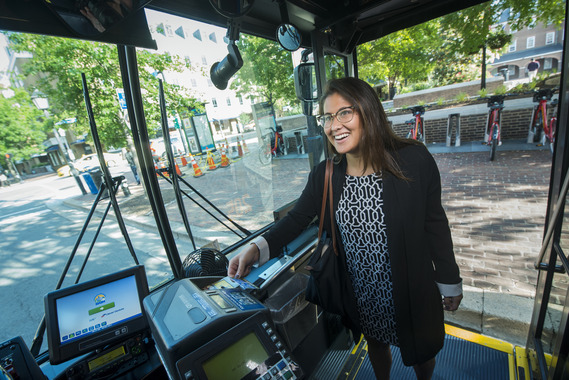 Fiscal Year 2024 ridership numbers are in for Virginia’s 40 public transit providers. In short – 126.6 million riders set a post-pandemic high, and the majority of transit agencies saw year-over-year increases in ridership.
An earlier Data Story delved into transit ridership recovery coming out of the pandemic, noting that ten public transit agencies (or one in four in Virginia) have met or exceeded pre-pandemic ridership levels. Meanwhile, statewide transit ridership (excluding WMATA or VRE) was on track to reach 90% of pre-pandemic levels by the end of the fiscal year. Now that Fiscal Year data are in, we know that 2024 ridership is at over 126 million, approximately 90% of pre-pandemic levels, a 21% increase over the prior fiscal year, 34 of Virginia’s 40 public transit agencies have year-over-year ridership increases, and Virginia’s transit ridership increases continue. The chart below shows the total Virginia public transit ridership for the prior 5 fiscal years:

The next chart shows the month-to-month ridership trends for Fiscal Year 2024. Fluctuations can be attributed to holidays when commuting decreases, vacations, college students in or out of classes, or smaller factors like the weather, sporting events, and the length of the month.
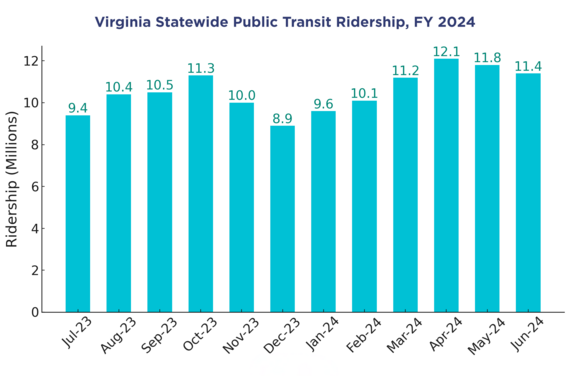
|
|
Top Ten by Ridership
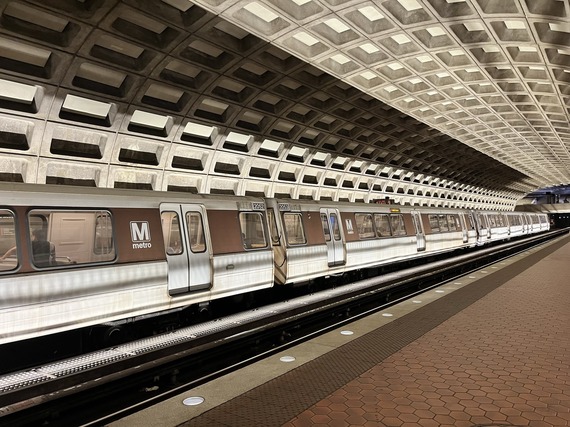
Virginia’s public transit providers come in all shapes and sizes, from the United States’ 2nd largest provider of public transit that operates subways, express and local buses, and paratransit services, to transit agencies that operate in relatively low-density rural areas and primarily offer microtransit services. That is not to say there is a hierarchy of transit systems, each plays an important role in its community, whether that role is to cater to commuters and take cars off of the road, or to provide access to critical services to those who do not or cannot drive.
That said, Virginia’s largest public transit agencies move millions of people annually and tens of thousands every day. The table below shows the top 10 public transit agencies by FY 2024 ridership:
|
|
The Washington Metropolitan Area Transportation Authority (WMATA) is first in ridership in Virginia. WMATA is the operator of Metrorail, Metrobus, and MetroAccess in Northern Virginia, and is one of the country’s largest public transit companies by annual ridership. (Note: the WMATA’s ridership numbers here only include WMATA trips that either began or ended in Virginia – individual passenger trips entirely within D.C. or Maryland are not included. Thus, the entire WMATA system’s ridership is significantly higher.) In second is the Greater Richmond Transit Company (GRTC). GRTC provides fixed-route and commuter bus, bus-rapid transit, paratransit, and microtransit service in the Richmond region, and its 10.8 million trips in FY 2024 is the agency’s highest ridership in well over a decade.
Rounding out the ridership podium places is the Fairfax Connector, which provides local and express bus service primarily in Fairfax County, with some services connecting to neighboring cities and counties, as well as to Dulles International Airport, and Washington D.C.
The fourth largest, Hampton Roads Transit (HRT) provides public transportation to six localities within the Hampton Roads region (except for Suffolk which has Suffolk Transit and Poquoson). HRT is unique among Virginia’s public transit agencies as the sole provider of both light rail (the Tide) and ferry service as public transit (the Elizabeth River Ferry).
Rounding out the top five is DASH (Driving Alexandrians Safely Home) is the public transit provider in the City of Alexandria and provides local and express services in the City and into surrounding jurisdictions. DASH’s ridership of 5.4 million is its record highest ridership in over 40 years of service. Alexandria is working on developing its own bus-rapid transit system (BRT), with two BRT services both in the work: Duke Street In Motion and the West End Transitway.
|
|
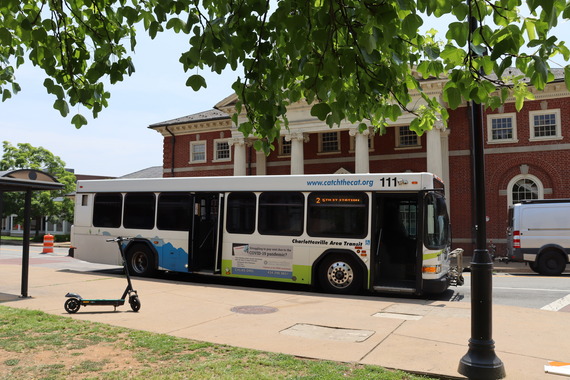
Ridership Increases
Fiscal Year 2024 saw a 21% increase in statewide ridership over FY 2023, driven by 34 of 40 public transit providers in Virginia seeing an increase in ridership. The table below shows the top 10 agencies by percentage increase in ridership, with their numeric increase for context:
|
|
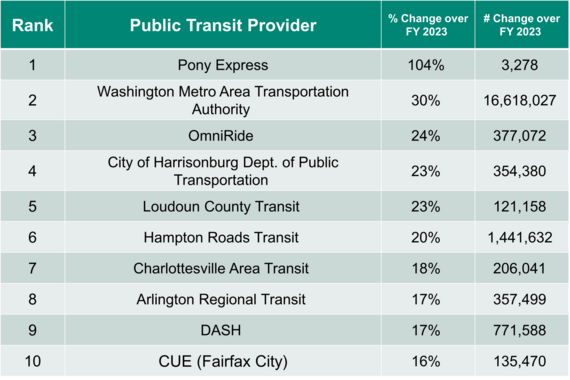
The Pony Express (not to be confused with the historic mail carrier) saw the largest year-over-year increase in ridership, more than doubling its ridership to a total of 6,423 in FY 2024. The Pony Express is a seasonal service provided by the Town of Chincoteague that operates from May until October during prime tourist season.
WMATA, as described above, is Virginia’s biggest provider of public transportation. WMATA also, as of FY 2024, had the second-largest percentage increase in ridership year-over-year, and by far the largest numeric increase in the Commonwealth. OmniRide, the public transit service provided by the Potomac and Rappahannock Transportation Commission, saw the third-largest percentage increase in ridership, followed by the Harrisonburg Department of Public Transportation and Loudoun County Transit.
There are 24 more public transit agencies that saw increases in ridership but did not make it onto the table. To explore these transit providers, feel free to explore, use, and download DRPT’s Transit Performance Data Dashboard and explore which transit providers grew over the past fiscal year!
|
|
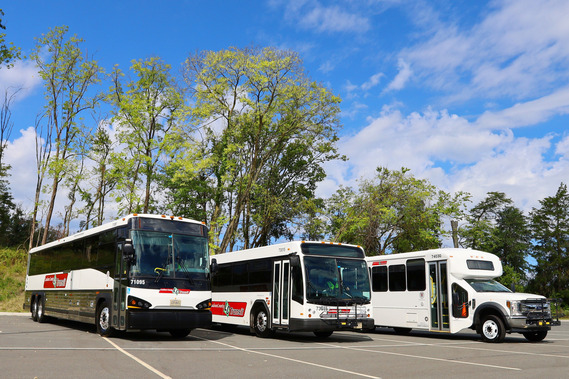
Modal Share
One final statistic is the share each mode of public transit has. In other words, what percentage of all trips were taken on buses, subways, or all other forms of public transit? In short, two modes alone provided nearly 96% of all trips in Virginia in FY 2024: the bus and the subway. The chart below shows the share of public transit trips in Virginia by transit mode:
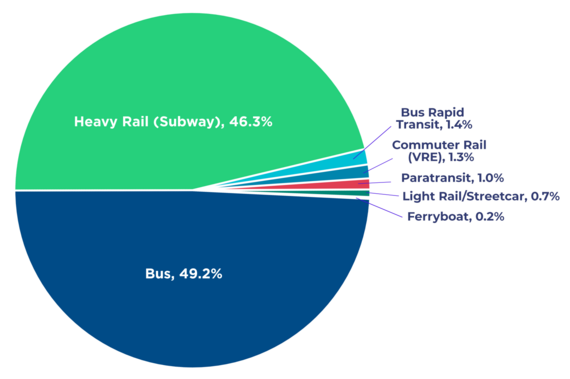 Fiscal Year 2024 ridership set records for many public transit agencies and continues Virginia’s steady climb in ridership since the pandemic ended. With 34 of 40 public transit agencies increasing ridership year-over-year, Virginia continues to go from strength to strength. Additionally, DRPT’s strategic plan, Next Stop: 2030 challenges the agency to increase statewide transit ridership year-over-year, with the Calendar Year 2024 goal of providing 130 million trips. DRPT is well on its way to meeting that goal. Beyond DRPT’s strategic plan, ridership numbers are used by DRPT to calculate Virginia’s contribution to each public transit agency’s operating budget. This ensures that DRPT remains a good steward of public resources by maximizing the benefit of public funds.
|
|
 DRPT’s mission is to connect and improve the quality of life for all Virginians with innovative transportation solutions. The SYIP turns that mission into action, by funding rail and public transportation priorities. With funding from the SYIP, transit agencies across Virginia provide over 10 million trips per month on buses, light rails, and subways. Freight rail programs divert around 14 million trucks from Virginia’s roads and attract hundreds of new jobs. Having trouble viewing this email? View it as a Web page.
Follow Us
|
|
|
|
|